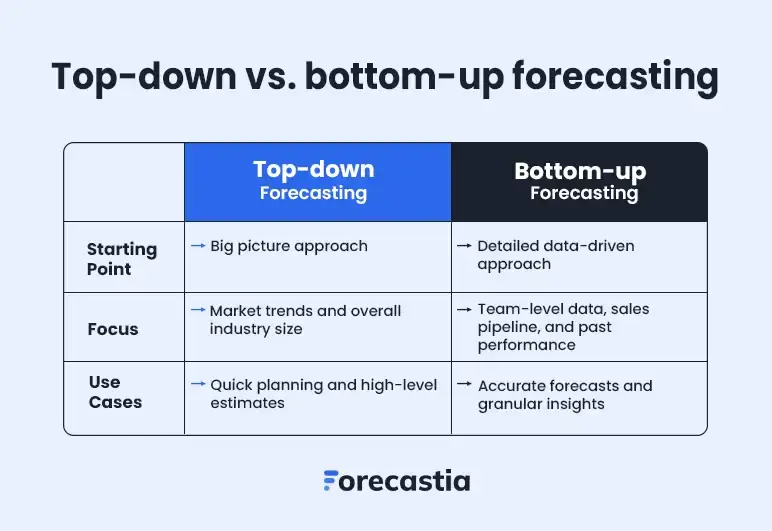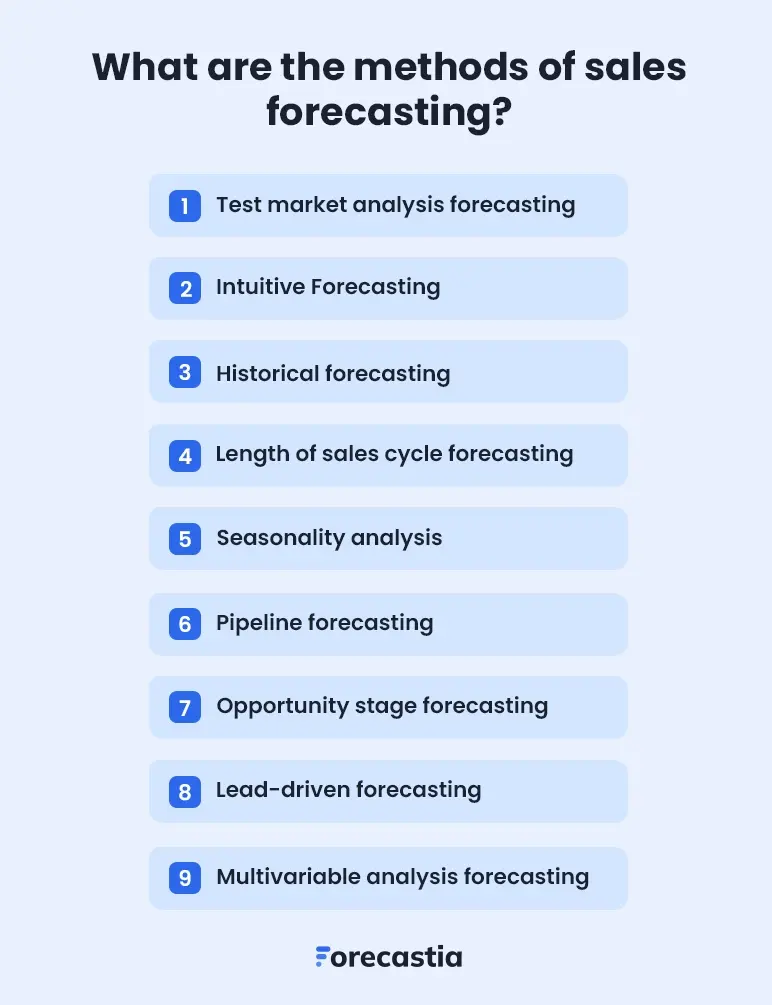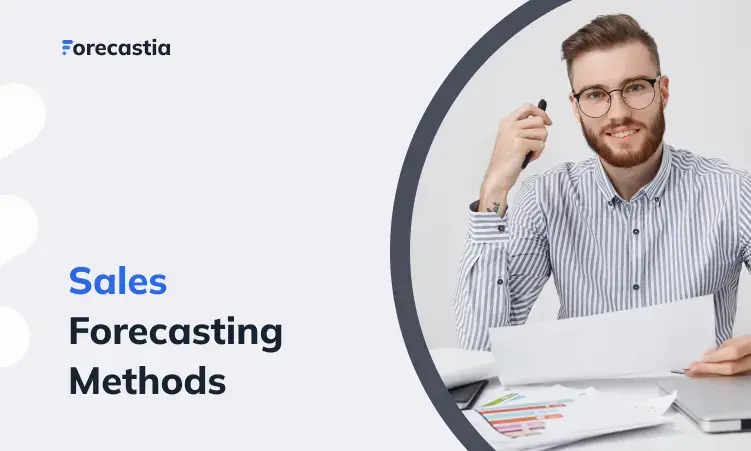Have you ever seen a sales forecast and thought, “No way that’s accurate”? If so, welcome to the club. Inaccurate sales forecasting is a universal pain point for businesses.
Sales forecasting accuracy often feels like a guessing game thanks to incomplete historical data, overlooked external factors, or, let’s face it, a little overconfidence.
But you don't have to live with bad forecasts. With the proper sales forecasting methods you can predict future sales revenue with confidence.
In this blog, we’ll discuss different sales forecasting methods so you can choose one to accurately predict sales revenue. Let’s turn those “maybe” predictions into results you can trust.
What is sales forecasting?
Sales forecasting is a process that uses historical sales data, market conditions, and trend evaluation to estimate future sales revenue. It helps businesses understand exactly how much inventory they’ll need, how much revenue to expect, what kind of goals to set, and more.
The process when done accurately improves budgeting, resource allocation, and overall business strategy.
Top-down vs. bottom-up forecasting
When it comes to sales forecasting, the approach matters as much as the number. You've got options: top-down forecasting and bottom-up forecasting.
Which one’s right for you? That depends on your business, your data, and what you’re trying to achieve. Let’s explore the differences.

Top-down forecasting takes a macro view. You start with the total market size and estimate your share. It’s quick, efficient, and great for high-level planning. But it’s not always the most accurate—it might overlook important details, like your team’s capacity or sales pipeline trends.
Bottom-up forecasting, on the other hand, starts at the ground level. It builds predictions based on old sales data, sales cycle length, and even individual sales figures. This approach delivers detailed accuracy but can be time-consuming and overwhelming.
Choosing the wrong approach for your business is a common mistake. Make sure your method aligns with your data and forecasting needs.
The right choice depends on your goals. If you’re in a hurry or need a market-wide perspective, top-down works great. But if accuracy is your priority, bottom-up is your best bet.
What are the methods of sales forecasting?
Sales forecasting isn’t as simple as picking one method and running with it. All of them fall into three main categories: qualitative, time series, and causal forecasting.
To understand how these work, we’ll break down each sales forecasting model category and explore the specific methods within them.

Qualitative forecasting
When you don’t have historical data to lean on, the qualitative sales forecast methods have your back. It’s all about relying on expert opinions, market research, and a healthy dose of intuition. Sure, it’s not as precise as number-crunching methods, but it’s perfect for businesses testing the waters with new products or entering unfamiliar territory.
Here are the qualitative sales forecasting models:
1) Test market analysis forecasting
If launching a product feels risky, this sales forecasting methodology helps businesses evaluate their ideas by first testing in a small market. Instead of diving in blindly, you can predict future sales revenue using relevant data from the test.
How does it work?
A business identifies a specific test market. It could be a city, a store, or even a social media ad campaign. They launch the product or campaign in this market and begin collecting sales figures and customer feedback.
Teams collect sales figures, customer engagement metrics, and feedback, often using sales forecasting software for automation. Once the data is ready, businesses analyze it to understand sales trends, identify potential risks, and improve accurate sales forecasts.
Suitable for:
- Businesses planning marketing campaigns or product launches.
- Teams working without substantial historical revenue data.
Pros
- Provides real-world insights to predict future demand.
- Reduces risk and improves sales forecasting accuracy.
Cons
- Insights are limited to the test market.
- The process can be resource-heavy.
2) Intuitive forecasting
Intuitive sales forecasting relies on the experience and instincts of salespeople to estimate potential sales figures. Unlike data-driven methods, this approach focuses on the sales rep’s ability to assess deals based on their career knowledge, market shifts, and daily interactions with customers and collaborators.
How does it work?
During pipeline reviews, sales managers ask reps for their thoughts on deals. Reps might say, “This deal is a sure thing. They’ll close in a week.” These confidence levels become the primary data point for intuitive forecasting.
They rely on their understanding of customer behavior, competitor strategies, and the company’s internal environment. This knowledge includes market demand, competitive landscape, and internal factors like new hires, territory shifts, or changes in the sales pipeline.
Sales reps also interact with marketing, purchasing, and finance teams to estimate the probability of deal closures, forecast revenue, and set expectations for sales cycle timelines.
Suitable for:
- Teams with limited access to past sales information.
- Businesses seeking a quick overview of their sales funnel.
Pros
- Simple and quick to execute.
- Provides insights into the sales team’s perspective.
Cons
- Lacks reliability without reliable data.
- Opinions can skew accurate sales forecasts if unchecked.
Time series forecasting
Time series forecasting looks at previous sales data and predicts what’s next. This method thrives on the idea that past patterns often repeat. Businesses use it to plan for future sales, market trends, and more. If you’ve got numbers from the past, time series forecasting can turn them into predictions for the future.
Some of the time series forecasting includes:
3) Historical forecasting
This forecasting relies on past sales data to estimate future sales revenue. Businesses can make educated guesses about their upcoming sales by analyzing trends from previous months, quarters, or years. Historical sales forecasting is simple but requires good record-keeping to work effectively.
How does it work?
The historical forecasting process begins with gathering past sales data from reports or CRMs. Teams examine growth rates, seasonal fluctuations, and sales funnel trends to identify recurring patterns. Businesses use these trends to calculate sales revenue estimates for upcoming months, quarters, or years.
For example, if December sales consistently jump by 20%, the forecast includes a similar increase. While historical sales forecasting is fairly simple, it doesn’t automatically account for sudden changes like market disruptions or new competitors.
Suitable for:
- Teams that need simple, efficient forecasting.
- Businesses operating in stable industries with predictable sales trends.
Pros
- Easy to use with access to reliable data.
- Great for industries with stable market trends.
Cons
- Doesn’t adapt to significant changes in market conditions.
- Assumes past trends will hold, which isn’t always true.
4) Length of sales cycle forecasting
The length of sales cycle method lets you predict revenue based on how long deals typically take to close. By using historical sales data, you can estimate when current opportunities will turn into dollars.
How does it work?
It starts with analyzing historical sales cycle data—the time it takes from the first contact with a prospect to closing the deal. Businesses calculate the average cycle length by reviewing past closed deals. Once the average is determined, they apply it to current opportunities in the sales workflow.
An example can be if your team has an average cycle length of 90 days, and an opportunity has been active for 45 days, you can estimate that it’s halfway through the cycle. By multiplying the potential deal size by its likelihood to close, businesses generate sales forecasts based on the cycle’s length.
Suitable for:
- Teams with predictable sales cycles.
- Businesses that want quick forecasts for active deals.
Pros
- Saves time with straightforward calculations.
- Gives clear timelines for sales in the future.
Cons
- Assumes all deals follow the same timeline.
- Struggles with unpredictable factors or complex deals.
5) Seasonality analysis
Seasonality analysis forecasting focuses on predicting sales trends tied to specific times of the year, like holidays or seasonal events. This method can be your go-to to handle predictable demand spikes. If your business booms during holidays or slows down in off-seasons, this method helps you prepare in advance.
How does it work?
Businesses review historical sales data to identify repeated patterns, such as holiday rushes or seasonal slowdowns. These patterns help forecast sales revenue for similar periods.
For instance, if your winter sales typically jump 30%, you can plan inventory management, staffing, and marketing campaigns accordingly.
Suitable for:
- Retailers, travel companies, or industries with seasonal peaks.
- Businesses looking to manage inventory better during demand surges.
Pros
- Highly accurate for businesses with clear seasonal demand.
- Helps plan resources effectively for peak periods.
Cons
- Requires detailed past sales information.
- Doesn’t handle unpredictable external factors like extreme weather
Causal forecasting models
Causal forecasting combines historical sales data with internal and external factors to create precise predictions. It’s for businesses that want to know more than just “what happened”—they want to know why it happened and how to improve it. It’s for teams that want to understand how different factors influence their sales performance.
Here are some of the causal forecasting models:
6) Pipeline forecasting
Pipeline forecasting is a sales forecasting model that predicts future revenue by analyzing active deals in your sales workflow and estimating their likelihood of closing. It’s perfect if you want to know exactly how close you are to hitting your revenue goals—or how much more work you’ve got to do.
How does it work?
The process starts with assessing every opportunity in the sales pipeline. Each deal is categorized based on its progress—early-stage, mid-pipeline, or near close. A probability is then assigned to each stage (e.g., 20% for early-stage deals, and 75% for deals close to closing). The potential revenue from each deal is multiplied by its probability of closing, and the results are summed up to forecast sales revenue in total.
For instance, if a sales rep has three deals worth $10,000 each, with closing probabilities of 25%, 50%, and 75%, the forecasted revenue would be:
- Deal 1: $10,000 x 25% = $2,500
- Deal 2: $10,000 x 50% = $5,000
- Deal 3: $10,000 x 75% = $7,500
Forecast total = $15,000
Suitable for:
- Teams with well-organized pipelines.
- Businesses that want to predict sales based on active opportunities.
Pros
- Straightforward and easy to implement.
- Great for improving sales performance visibility.
Cons
- Requires reliable data and regular CRM updates.
- Can falter with inconsistent sales inputs.
7) Opportunity stage forecasting
Opportunity stage forecasting predicts future revenue by grading deals in your sales process flow based on how close they are to closing. Each stage, from "Lead Qualification" to "Closed/Won," is assigned a probability reflecting the likelihood of closing. Sales leaders opting for opportunity stage forecasting get better insights and, for reps, it gets easy to justify that "hot lead" they keep talking about.
How does it work?
Every deal in the pipeline is assigned a stage, like "Initial Contact," "Negotiation," or "Closed/Won." Each stage in the opportunity stage forecasting is linked to a closing probability—for example, 10% for early-stage deals and 90% for opportunities near the final stage.
Sales teams multiply the deal’s value by its assigned probability to calculate revenue. For instance, a $20,000 deal at a 75% probability yields a forecasted revenue of $15,000. The sum of all forecasted revenues gives the total upcoming sales revenue.
Suitable for:
- Teams with defined sales cycle stages.
- Companies with CRM systems that track sales funnel progress.
- Businesses that want structured and regular forecasting methods.
Pros
- Helps visualize deal progress.
- Provides structured sales forecasting methods.
Cons
- Can falter if reps overestimate probabilities.
- Requires constant CRM updates.
8) Opportunity creation forecasting
Opportunity creation forecasting is your go-to method for answering, “What makes a great customer?” It studies closed deals to identify what your top buyers have in common, like size, location, or lead source. Then, it compares these traits to active opportunities to predict how likely they are to close.
How does it work?
The process begins by analyzing your historical sales data to determine what traits successful deals have in common. This might include customer size, lead source, or industry type. For example, if most of your high-value customers have 500+ employees and discovered you through a specific campaign, you’ll use this profile to assess your current opportunities.
From there, businesses calculate an average close rate for opportunities that match those traits and apply it to the active pipeline.
Suitable for:
- Teams looking to optimize sales forecasting accuracy by understanding their ideal customer profiles.
- Organizations using a sales workflow with clear lead information.
Pros
- Improves targeting by focusing on proven patterns.
- Increases the chances of accurate forecasts for high-value leads.
Cons
- Data-heavy and time-consuming.
- Requires clear trends in your past data.
9) Lead-driven forecasting
Lead-driven forecasting answers the age-old sales question: “Which leads are worth our time?” It helps your sales team prioritize opportunities by analyzing which lead sources—referrals, ads, or webinars—have historically delivered the most revenue. By assigning value to each lead type, it creates a precise forecast of sales.
How does it work?
Sales teams start by analyzing historical data to gather:
- The number of leads acquired per month for a given period.
- The lead-to-customer conversion rate for each lead source.
- The average sale price associated with each source.
From there, the sales team assigns each lead source a value based on its track record. For example, if webinar leads convert faster than social media ads, they’ll carry more weight in your forecast. Just keep in mind, if marketing launches a surprise campaign, you might need to re-forecast.
Suitable for
- Businesses with a steady stream of inbound leads.
- Businesses that rely on sales funnel data to refine their forecasting mode.
Pros
- Simplifies sales pipeline analysis.
- Increases the chances of accurate forecasts by focusing on proven performers.
Cons
- Requires actual sales data from a consistent CRM.
- Marketing and macro changes can shake things up.
10) Multivariable analysis forecasting
This method of forecasting is the jack-of-all-trades and one of the best sales forecasting methods. It analyzes every factor—pricing, customer behavior, and economic trends—and puts them into one cohesive model. If you’re managing many moving parts, this method will keep things in check.
How does it work?
The process starts with selecting key variables, like pricing strategies, marketing budgets, and seasonal trends, which are likely to impact upcoming sales. After that, businesses gather past data, market insights, and customer behavior patterns to build a dataset.
Using advanced techniques like regression analysis or machine learning, they analyze how these factors influence sales. Finally, they use these insights to create a forecasting model that delivers a clear picture of revenue—turning all that data into actionable business sales strategies.
Suitable for:
- Companies with a complex sales funnel and access to strong data.
- Teams operating in industries with unpredictable market shifts.
- Teams that want forecasts tied to actionable insights.
Pros
- Covers both internal and external influences.
- Improves sales forecasting accuracy for dynamic environments.
Cons
- Heavy on tools, time, and data expertise.
- Not suitable for small teams or limited datasets.
Key takeaway
| Technique | Use | Pros | Cons |
|---|---|---|---|
| Test market analysis forecasting | Evaluate market potential by testing in a specific market. | Provides real-world insights into market demand. | Insights are limited to test market scope. |
| Intuitive forecasting | Estimate sales based on salesperson intuition and experience. | Quick and simple to implement. | Prone to bias and lacks data reliability. |
| Historical forecasting | Predict sales using historical data. | Easy to use with historical data. | Doesn’t adapt to sudden market shifts. |
| Length of sales cycle forecasting | Predict revenue based on the average deal cycle. | Gives clear timelines for deal closures. | Assumes uniform deal timelines, which may not hold true. |
| Seasonality forecasting | Forecast sales trends tied to seasonal patterns. | Highly accurate for seasonal businesses. | Requires detailed historical data. |
| Pipeline forecasting | Estimate revenue from active deals in the pipeline. | Improves visibility into sales pipeline health. | Relies on consistent CRM data. |
| Opportunity stage forecasting | Predict sales based on deal progression in the pipeline. | Offers detailed insights into deal progression. | Requires accurate deal probability inputs. |
| Opportunity creation forecasting | Analyze traits of top buyers to predict opportunity success. | Improves targeting by focusing on proven buyer traits. | Data-heavy and time-consuming. |
| Lead driven forecasting | Prioritizes sales leads based on historical performance. | Simplifies lead prioritization and pipeline analysis. | Heavily reliant on consistent historical lead data. |
| Multivariable analysis forecasting | Analyze multiple variables to predict sales trends. | Comprehensive analysis of internal and external factors. | Time-intensive and requires expertise. |
Which sales forecasting method is the best?
There’s no universal “best” forecasting model, but there’s a “best for you” option, (provided you make no sales forecasting mistakes. And it depends on your starting point and goals. Identifying these factors is essential because choosing the right sales forecasting model.
Qualitative forecasting models are a great place to start if your business lacks historical data. For companies with a wealth of data, time series forecasting or sales cycle forecasting can deliver more accurate forecasts.
Overcomplicating things isn’t the answer. If your sales team struggles with data management, avoid complex forecasting models. Instead, ask yourself:
- How much historical data do we have?
- Are market conditions stable or volatile?
- Do we need quick insights or in-depth predictions?
Example scenario:
A mid-sized e-commerce business operating for five years wants to forecast future holiday sales.
- Qualitative forecasting: For a new product, they use test market analysis to predict future demand, testing it with a small audience.
- Time series forecasting: With five years of sales cycle data, they analyze seasonal trends for inventory and staffing.
- Causal forecasting: They factor in market conditions, such as competitor discounts, to refine predictions.
- Decision: The company combines the time series forecasting model for seasonal trends with qualitative forecasting for their new product, ensuring they align inventory, meet future demand, and plan effective campaigns.
Prepare accurate sales projections using AI
Manual forecasting is exhausting—and honestly, why do it the hard way when AI exists? AI tools analyze your historical forecasting data, track market trends, and craft forecasting models that help you predict future sales based on facts.
Need to estimate next quarter’s revenue? Or figure out if you’re meeting your sales cycle targets? AI can crunch the numbers in minutes, saving you hours of effort and potential errors.
If clarity and efficiency are what you’re after, Forecastia is here to help. It’s a sales forecasting software that will help you forecast sales for any given business type, regardless of how complex or unpredictable your revenue streams or sales processes may be. It even integrates with QuickBooks and Xero, simplifying your entire forecasting and business planning process.
So what say? Let Forecastia power your forecasts.
Frequently Asked Questions
What are sales forecasting models?
Sales forecasting models are the tools and techniques businesses use to predict sales based on historical data, market trends, and internal factors like the sales workflow. These models help businesses plan inventory, allocate resources, and set realistic goals.
What are the most common sales forecasting methods?
The most common sales forecasting methods are:
- Historical forecasting
- Pipeline forecasting
- Opportunity stage forecasting
- Lead-driven forecasting
- Test market analysis
- Intuitive forecasting
- Length of sales cycle forecasting
- Multivariable analysis forecasting
- Time series analysis
- Causal forecasting
Which tools can be used for sales forecasting?
You can use:
ChatGPT: Assists with sales forecasting by analyzing past sales data, providing insights on market trends, and generating tailored forecasting models. However, it can’t replace specialized software.
Forecastia: Designed to simplify the entire process of forecasting. With features like historical forecasting, QuickBooks/Xero integration, and AI-driven insights, it helps businesses predict future sales based on authentic data.
What factors affect sales forecasting?
Factors affecting forecasting include pricing policies, marketing strategies, workforce size, product quality, and financial distribution. Adjustments to any of these elements can lead to fluctuations in sales, ultimately impacting the accuracy of your future revenue forecasts.

